�
KALMAN FILTERING AND
NEURAL NETWORKS
KALMAN FILTERING AND
NEURAL NETWORKS
Edited by
Simon Haykin
Communications Research Laboratory,
McMaster University, Hamilton, Ontario, Canada
New York = Chichester = Weinheim = Brisbane = Singapore = Toronto
A WILEY-INTERSCIENCE PUBLICATION
JOHN WILEY & SONS, INC.
�
Designations used by companies to distinguish their products are often claimed as
trademarks. In all instances where John Wiley & Sons, Inc., is aware of a claim, the
product names appear in initial capital or ALL CAPITAL LETTERS. Readers, however, should
contact the appropriate companies for more complete information regarding trademarks
and registration.
Copyright 2001 by John Wiley & Sons, Inc.. All rights reserved.
No part of this publication may be reproduced, stored in a retrieval system or transmitted
in any form or by any means, electronic or mechanical, including uploading,
downloading, printing, decompiling, recording or otherwise, except as permitted under
Sections 107 or 108 of the 1976 United States Copyright Act, without the prior written
permission of the Publisher. Requests to the Publisher for permission should be
addressed to the Permissions Department, John Wiley & Sons, Inc., 605 Third Avenue,
New York, NY 10158-0012, (212) 850-6011, fax (212) 850-6008,
E-Mail: PERMREQ@WILEY.COM.
This publication is designed to provide accurate and authoritative information in regard to
the subject matter covered. It is sold with the understanding that the publisher is not
engaged in rendering professional services. If professional advice or other expert
assistance is required, the services of a competent professional person should be sought.
ISBN 0-471-22154-6
This title is also available in print as ISBN 0-471-36998-5.
For more information about Wiley products, visit our web site at www.Wiley.com.
�
CONTENTS
Preface
Contributors
1 Kalman Filters
Simon Haykin
Introduction = 1
1.1
1.2 Optimum Estimates = 3
1.3 Kalman Filter = 5
1.4 Divergence Phenomenon: Square-Root Filtering = 10
1.5 Rauch–Tung–Striebel Smoother = 11
1.6 Extended Kalman Filter = 16
1.7 Summary = 20
References = 20
2 Parameter-Based Kalman Filter Training:
Theory and Implementation
Gintaras V. Puskorius and Lee A. Feldkamp
Introduction = 23
2.1
2.2 Network Architectures = 26
2.3 The EKF Procedure = 28
2.3.1 Global EKF Training = 29
2.3.2 Learning Rate and Scaled Cost Function = 31
2.3.3 Parameter Settings = 32
2.4 Decoupled EKF (DEKF) = 33
2.5 Multistream Training = 35
xi
xiii
1
23
v
�
vi
CONTENTS
2.5.1 Some Insight into the Multistream Technique = 40
2.5.2 Advantages and Extensions of Multistream
Training = 42
2.6 Computational Considerations = 43
2.6.1 Derivative Calculations = 43
2.6.2 Computationally Efficient Formulations for
Multiple-Output Problems = 45
2.6.3 Avoiding Matrix Inversions = 46
2.6.4 Square-Root Filtering = 48
2.7 Other Extensions and Enhancements = 51
2.7.1 EKF Training with Constrained Weights = 51
2.7.2 EKF Training with an Entropic Cost Function = 54
2.7.3 EKF Training with Scalar Errors = 55
2.8 Automotive Applications of EKF Training = 57
2.8.1 Air=Fuel Ratio Control = 58
2.8.2 Idle Speed Control = 59
2.8.3 Sensor-Catalyst Modeling = 60
2.8.4 Engine Misfire Detection = 61
2.8.5 Vehicle Emissions Estimation = 62
2.9 Discussion = 63
2.9.1 Virtues of EKF Training = 63
2.9.2 Limitations of EKF Training = 64
2.9.3 Guidelines for Implementation and Use = 64
References = 65
3 Learning Shape and Motion from Image Sequences
69
Gaurav S. Patel, Sue Becker, and Ron Racine
Introduction = 69
3.1
3.2 Neurobiological and Perceptual Foundations of our Model = 70
3.3 Network Description = 71
3.4 Experiment 1 = 73
3.5 Experiment 2 = 74
3.6 Experiment 3 = 76
3.7 Discussion = 77
References = 81
�
4 Chaotic Dynamics
Gaurav S. Patel and Simon Haykin
CONTENTS
vii
83
Introduction = 83
4.1
4.2 Chaotic (Dynamic) Invariants = 84
4.3 Dynamic Reconstruction = 85
4.4 Modeling Numerically Generated Chaotic Time Series = 87
4.4.1 Logistic Map = 87
4.4.2 Ikeda Map = 91
4.4.3 Lorenz Attractor = 99
4.5 Nonlinear Dynamic Modeling of Real-World
Time Series = 106
4.5.1 Laser Intensity Pulsations = 106
4.5.2 Sea Clutter Data = 113
4.6 Discussion = 119
References = 121
5 Dual Extended Kalman Filter Methods
123
Eric A. Wan and Alex T. Nelson
Introduction = 123
5.1
5.2 Dual EKF – Prediction Error = 126
5.2.1 EKF – State Estimation = 127
5.2.2 EKF – Weight Estimation = 128
5.2.3 Dual Estimation = 130
5.3 A Probabilistic Perspective = 135
5.3.1 Joint Estimation Methods = 137
5.3.2 Marginal Estimation Methods = 140
5.3.3 Dual EKF Algorithms = 144
5.3.4 Joint EKF = 149
5.4 Dual EKF Variance Estimation = 149
5.5 Applications = 153
5.5.1 Noisy Time-Series Estimation and Prediction = 153
5.5.2 Economic Forecasting – Index of Industrial
Production = 155
5.5.3 Speech Enhancement = 157
5.6 Conclusions = 163
Acknowledgments = 164
�
viii
CONTENTS
Appendix A: Recurrent Derivative of the Kalman Gain = 164
Appendix B: Dual EKF with Colored Measurement Noise = 166
References = 170
6 Learning Nonlinear Dynamical System Using the
Expectation-Maximization Algorithm
175
Sam T. Roweis and Zoubin Ghahramani
6.1 Learning Stochastic Nonlinear Dynamics = 175
6.1.1 State Inference and Model Learning = 177
6.1.2 The Kalman Filter = 180
6.1.3 The EM Algorithm = 182
6.2 Combining EKS and EM = 186
6.2.1 Extended Kalman Smoothing (E-step) = 186
6.2.2 Learning Model Parameters (M-step) = 188
6.2.3 Fitting Radial Basis Functions to Gaussian
Clouds = 189
6.2.4 Initialization of Models and Choosing Locations
for RBF Kernels = 192
6.3 Results = 194
6.3.1 One- and Two-Dimensional Nonlinear State-Space
Models = 194
6.3.2 Weather Data = 197
6.4 Extensions = 200
6.4.1 Learning the Means and Widths of the RBFs = 200
6.4.2 On-Line Learning = 201
6.4.3 Nonstationarity = 202
6.4.4 Using Bayesian Methods for Model Selection and
Complexity Control = 203
6.5 Discussion = 206
6.5.1 Identifiability and Expressive Power = 206
6.5.2 Embedded Flows = 207
6.5.3 Stability = 210
6.5.4 Takens’ Theorem and Hidden States = 211
6.5.5 Should Parameters and Hidden States be Treated
Differently? = 213
6.6 Conclusions = 214
Acknowledgments = 215
�
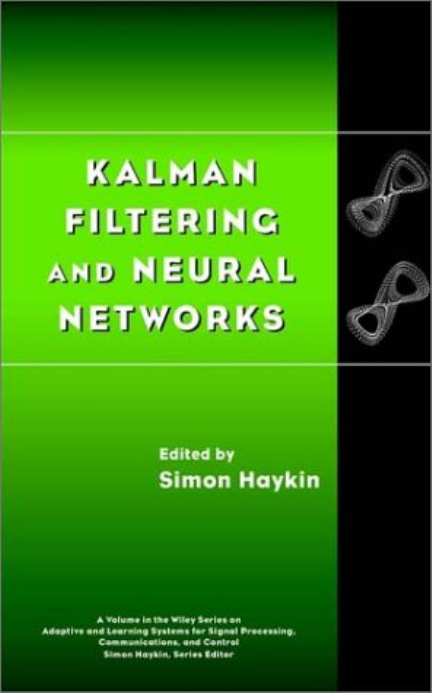
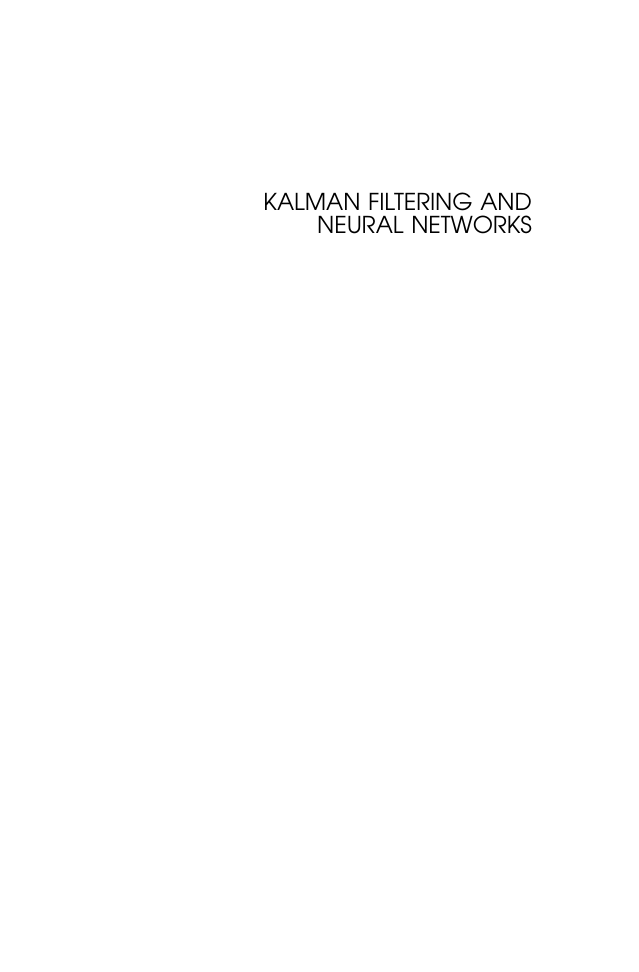
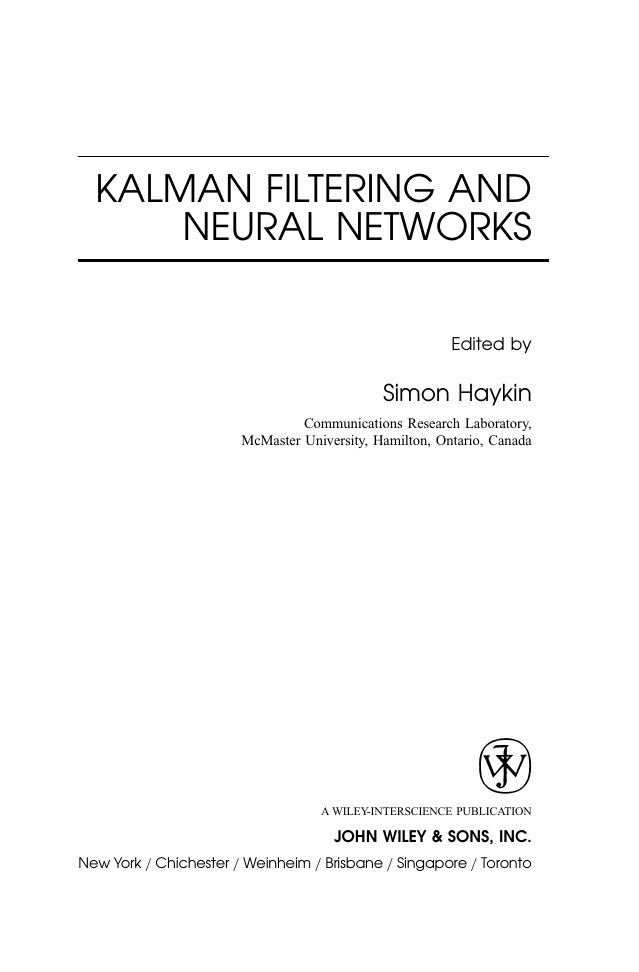
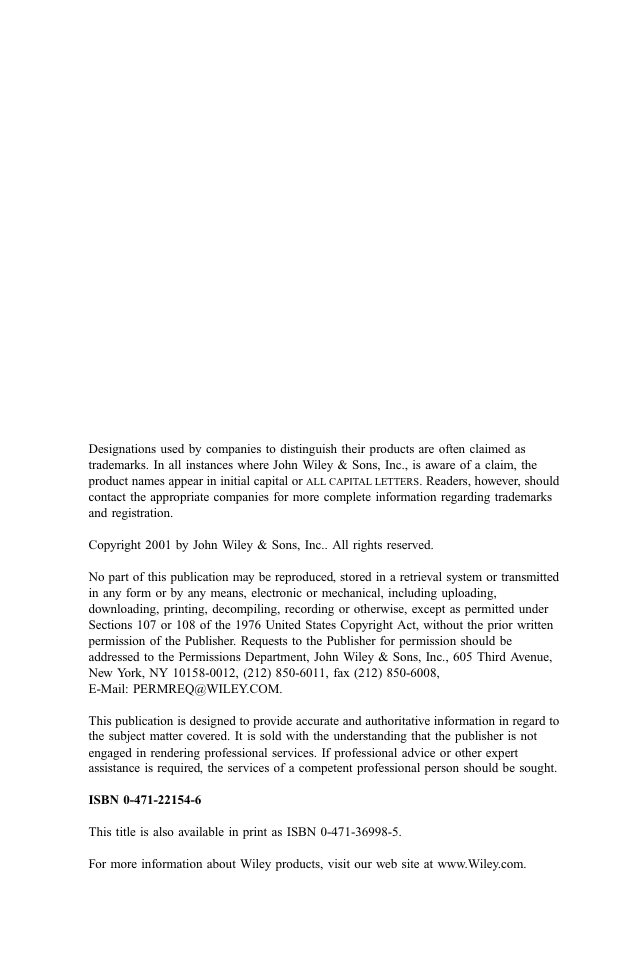
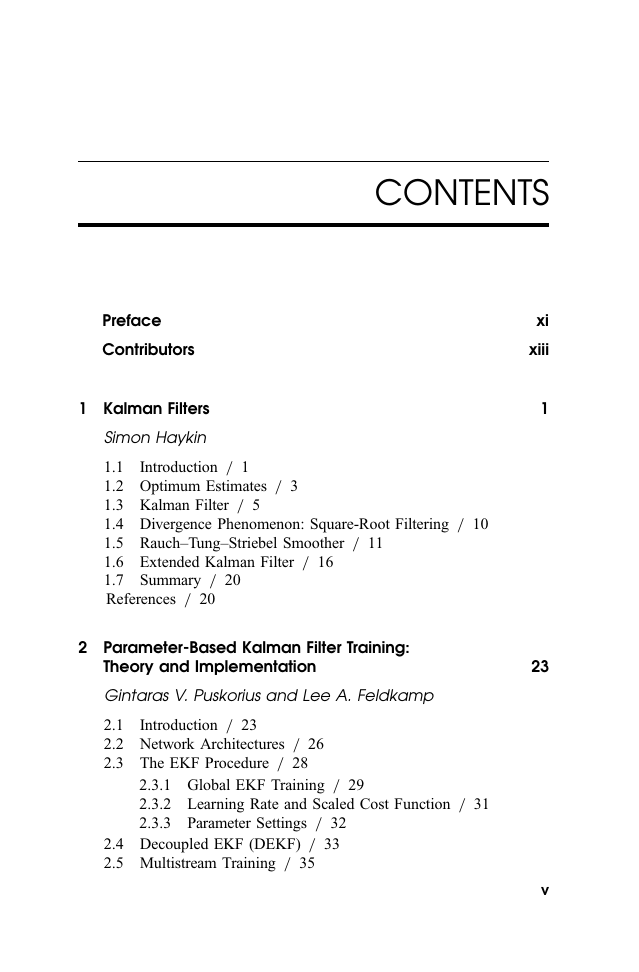
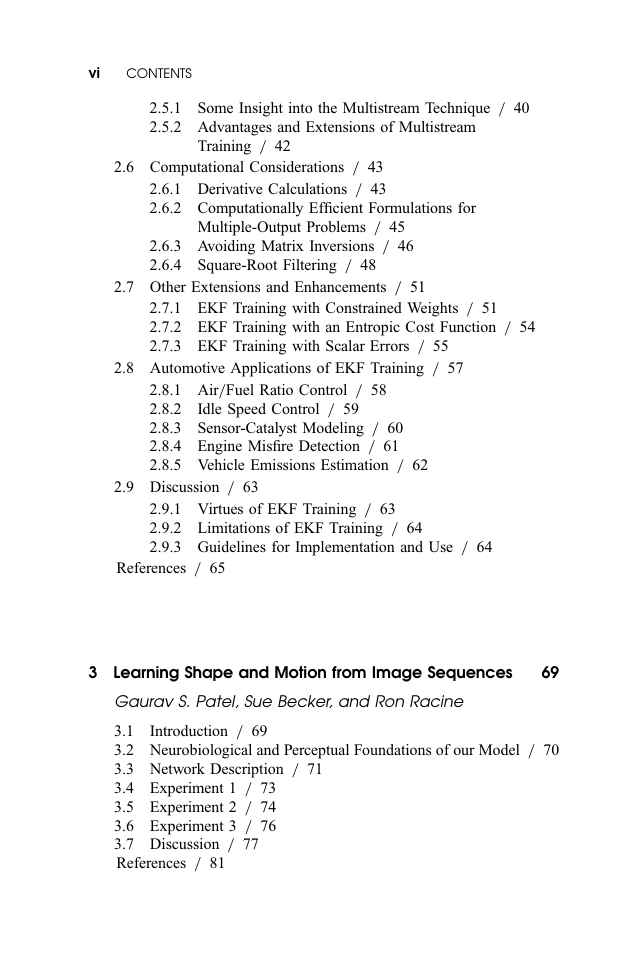
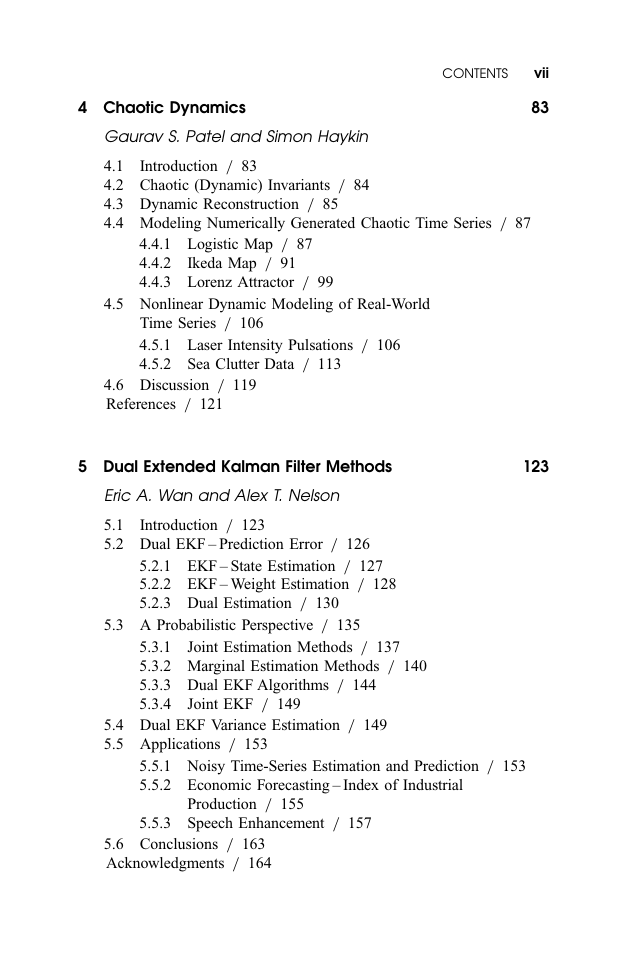
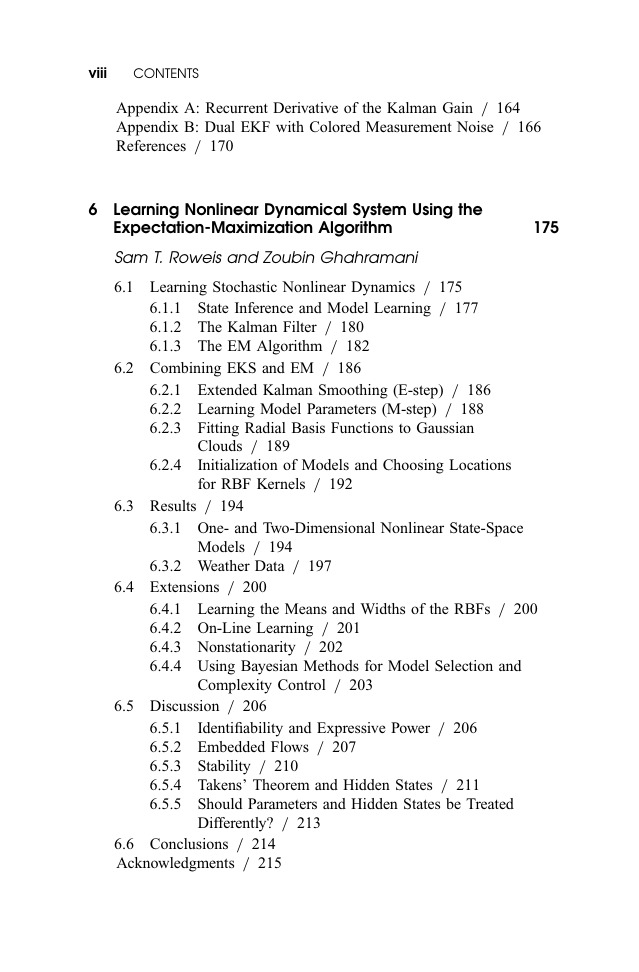








 2023年江西萍乡中考道德与法治真题及答案.doc
2023年江西萍乡中考道德与法治真题及答案.doc 2012年重庆南川中考生物真题及答案.doc
2012年重庆南川中考生物真题及答案.doc 2013年江西师范大学地理学综合及文艺理论基础考研真题.doc
2013年江西师范大学地理学综合及文艺理论基础考研真题.doc 2020年四川甘孜小升初语文真题及答案I卷.doc
2020年四川甘孜小升初语文真题及答案I卷.doc 2020年注册岩土工程师专业基础考试真题及答案.doc
2020年注册岩土工程师专业基础考试真题及答案.doc 2023-2024学年福建省厦门市九年级上学期数学月考试题及答案.doc
2023-2024学年福建省厦门市九年级上学期数学月考试题及答案.doc 2021-2022学年辽宁省沈阳市大东区九年级上学期语文期末试题及答案.doc
2021-2022学年辽宁省沈阳市大东区九年级上学期语文期末试题及答案.doc 2022-2023学年北京东城区初三第一学期物理期末试卷及答案.doc
2022-2023学年北京东城区初三第一学期物理期末试卷及答案.doc 2018上半年江西教师资格初中地理学科知识与教学能力真题及答案.doc
2018上半年江西教师资格初中地理学科知识与教学能力真题及答案.doc 2012年河北国家公务员申论考试真题及答案-省级.doc
2012年河北国家公务员申论考试真题及答案-省级.doc 2020-2021学年江苏省扬州市江都区邵樊片九年级上学期数学第一次质量检测试题及答案.doc
2020-2021学年江苏省扬州市江都区邵樊片九年级上学期数学第一次质量检测试题及答案.doc 2022下半年黑龙江教师资格证中学综合素质真题及答案.doc
2022下半年黑龙江教师资格证中学综合素质真题及答案.doc